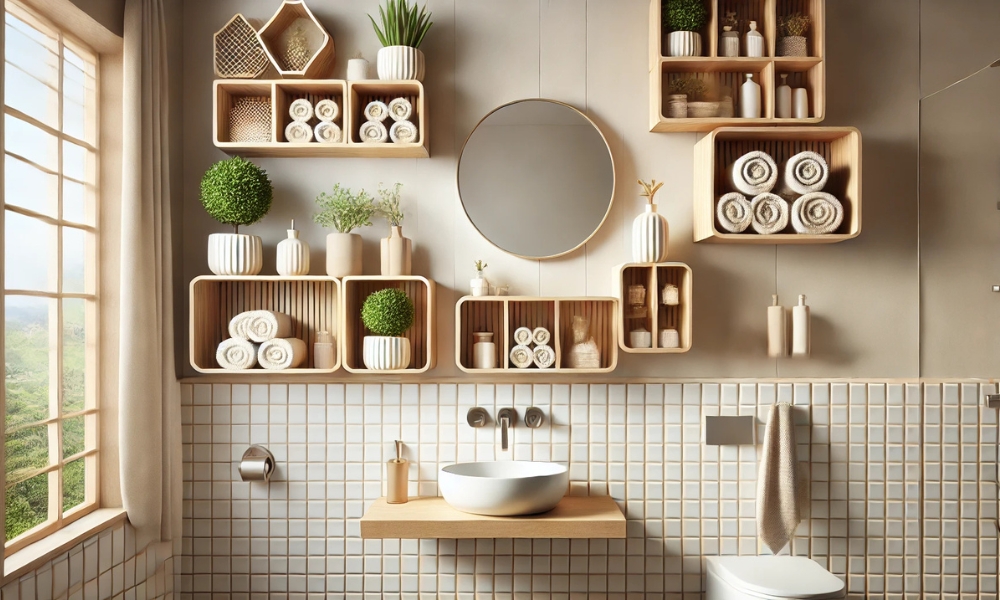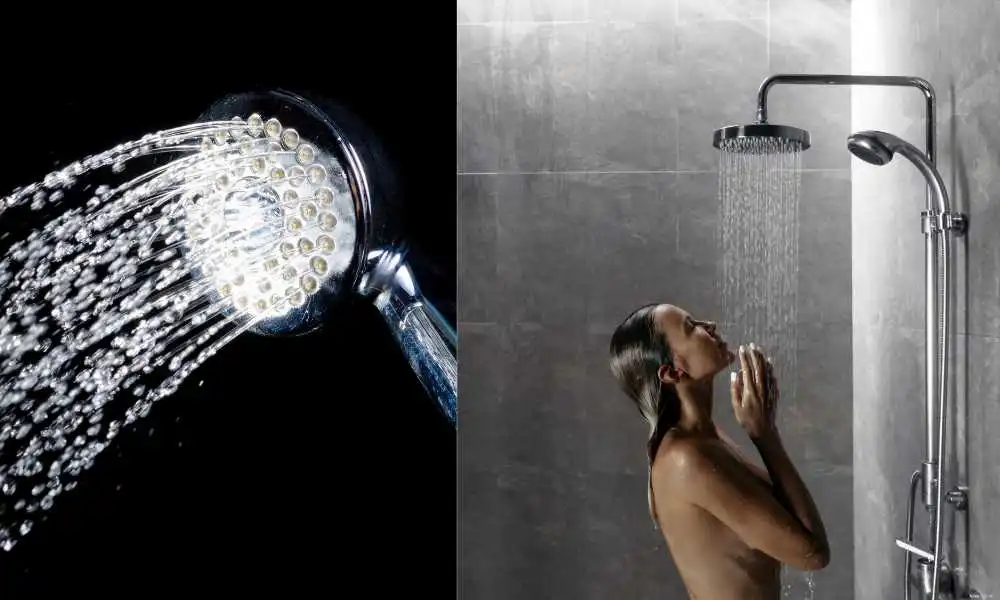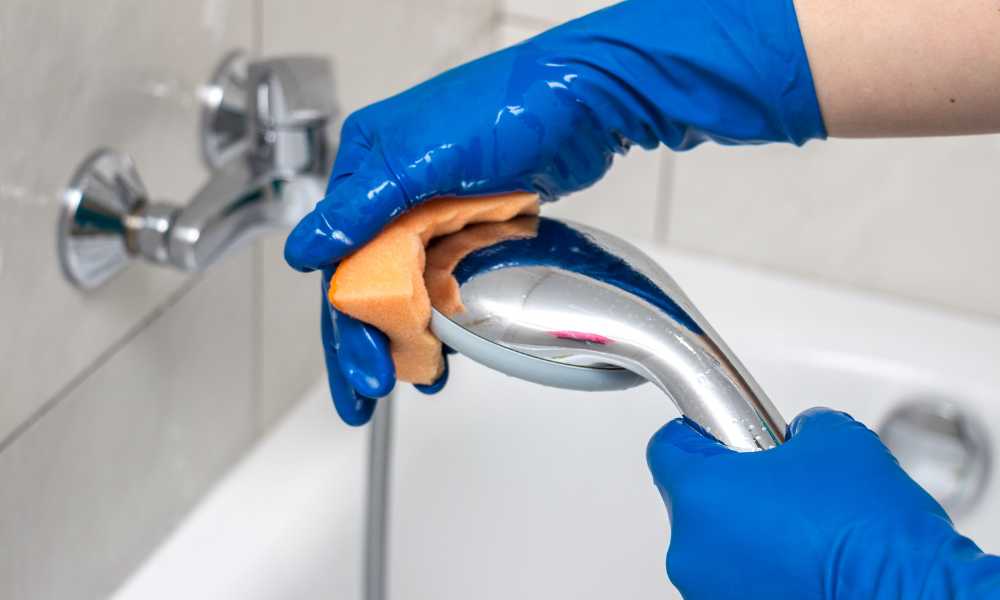When designing or revamping a bathroom, one of the key questions that arises is how far apart bathroom shelves should be placed. This decision is not merely about functionality—it also plays a crucial role in the overall aesthetics of your bathroom. Whether you are organizing toiletries, adding decorative elements, or maximizing storage, determining the proper spacing of shelves can make all the difference.
In this blog, we’ll explore practical guidelines, tips, and creative ideas to help you make the best choice for your bathroom shelving needs.
Why Proper Shelf Spacing Matters
Before diving into measurements and spacing rules, it’s essential to understand why the distance between shelves is important:
- Functionality: Incorrect spacing can make shelves impractical, either too cramped or too far apart, reducing their usability.
- Aesthetics: Uneven or poorly placed shelf can disrupt the visual flow of your bathroom. Proper spacing ensures a clean, organized appearance.
- Maximizing Space: Bathrooms often have limited square footage, so making the most of vertical wall space is critical. Correct shelf spacing can optimize storage without overcrowding.
- Safety: Shelves that are too close or improperly installed can lead to accidents, especially in a wet, slippery environment like a bathroom.
General Guidelines For Bathroom Shelf Spacing
Here are some basic principles to guide you:
1. Distance Between Shelves
The standard distance between bathroom shelf typically ranges from 8 to 12 inches, depending on what you plan to store.
- For toiletries: If the shelf is designated for small items like jars, makeup, or grooming tools, spacing of 8–10 inches works well.
- For larger items: For towels, storage baskets, or taller decorative pieces, consider a spacing of 12–15 inches.
2. Height From The Floor
- Lower shelves: If you’re installing a low shelf for easy access, it should be placed about 24–30 inches from the floor. This is especially useful for a shelf near the toilet or sink.
- Higher shelves: If you’re adding a decorative or less frequently used shelf, position it about 5–6 feet from the floor to avoid clutter at eye level.
3. Above Fixtures
- Above the toilet: Shelves above the toilet should start at least 10–12 inches above the tank to allow for easy cleaning and prevent items from being accidentally knocked over.
- Above the sink: If placing shelves above the sink, ensure there’s at least 15–20 inches of clearance to avoid obstruction when using the faucet or mirror.
Step-By-Step Guide To Determining Shelf Spacing
Step 1: Assess Your Needs
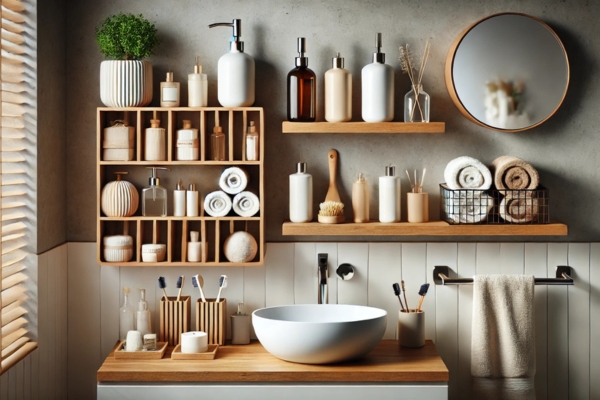
Before installing bathroom shelves, take a moment to evaluate what you’ll store and how you plan to use the space. Start by identifying the specific items you want to place on the shelves—this could include toiletries, towels, decorative pieces, or cleaning supplies. Once you’ve listed these items, group them by size and frequency of use.
For example, frequently used items like soaps, lotions, or toothbrush holders should be stored on easily accessible shelf, while less-used items, such as extra towels or seasonal decorations, can be placed on higher or lower shelves. This step ensures that your shelving is not only functional but also tailored to your daily routine, making your bathroom more organized and efficient.
Step 2: Measure Your Space
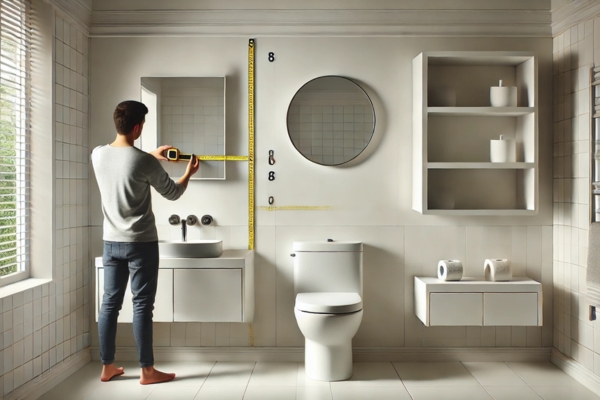
Accurate measurements are crucial to ensure your Put On Floating Shelves In Bathroom fit seamlessly into the available space. Start by measuring the wall area where you plan to install the shelves. Use a measuring tape to determine the height, width, and depth of the wall, taking into account how much space is available both vertically and horizontally. This will help you decide the ideal number of shelves and their spacing.
Next, consider nearby fixtures such as the toilet, sink, mirror, or towel bars. Ensure there’s adequate clearance around these elements to avoid overcrowding and to maintain functionality. For example, if you’re placing a shelf above the toilet, make sure there’s at least 10–12 inches of space above the tank for easy access and cleaning. Similarly, shelves near the sink should allow enough clearance—around 15–20 inches—to avoid interfering with daily tasks. Measuring your space thoroughly ensures your shelf will not only fit well but also enhance the overall layout and usability of your bathroom.
Step 3: Plan For Flexibility
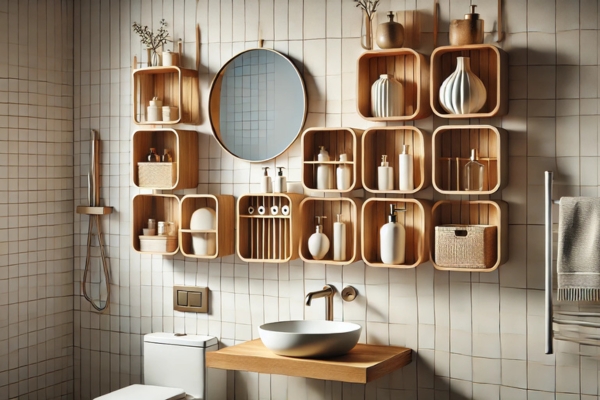
When designing your bathroom shelves, it’s important to think ahead and plan for changing storage needs. If you’re unsure about the exact spacing requirements, consider using adjustable shelving systems. These allow you to modify the distance between shelves easily, giving you the flexibility to adapt as your needs evolve over time.
For example, you might initially use tighter spacing of 8–10 inches for smaller toiletries but later adjust to 12–15 inches to store taller items like decorative vases or storage baskets. Adjustable shelves are especially useful in shared bathrooms, where the needs of multiple users can vary. By incorporating flexibility into your design, you’ll create a versatile and functional storage solution that grows with your lifestyle.
Step 4: Test Layouts
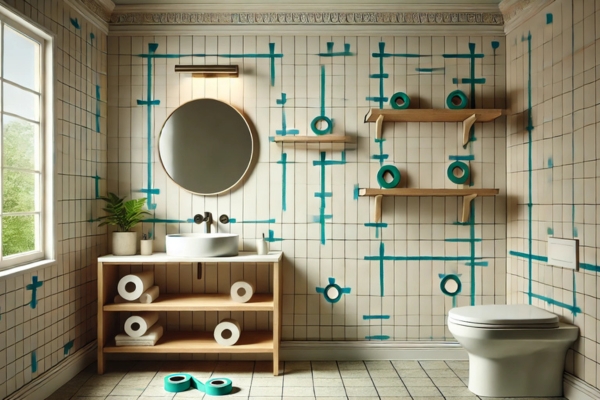
Before committing to drilling or installing your bathroom shelves, it’s a good idea to test out potential layouts. Use painter’s tape to mark the positions of your shelf on the wall. Outline the width and spacing of each shelf to create a visual guide that mimics how the final setup will look. This method allows you to evaluate the balance, symmetry, and functionality of the spacing without making permanent changes.
Take a step back and assess whether the layout meets your needs. For instance, check if the spacing allows enough clearance for taller items or if the shelves are at a comfortable height for access. You can also experiment with different arrangements to find what works best for your space. Testing layouts beforehand ensures you’ll achieve a well-thought-out design that’s both practical and visually appealing.
Spacing For Different Bathroom Styles
When it comes to bathroom shelving, the spacing should complement the style and size of the space for maximum functionality and aesthetic appeal. In small bathrooms, where space is often limited, it’s crucial to make every inch count. Floating shelves with a spacing of 10–12 inches are ideal for compact storage while preventing the walls from feeling overcrowded. To free up floor space, focus on vertical storage and use higher shelf for items that aren’t needed daily. This not only keeps the bathroom organized but also helps create a sense of openness in a tight area.
For luxury bathrooms, where the goal is to create a spa-like retreat, spaciousness is key. Wider shelf spacing of 15 inches or more allows you to incorporate decorative elements like scented candles, small potted plants, or neatly rolled towels, creating a serene and elegant atmosphere. The larger gaps between shelves add to the sense of luxury by providing an airy, uncluttered feel. By thoughtfully adjusting the spacing and styling to suit your bathroom’s design, you can achieve a look that’s both functional and visually appealing, regardless of the size or layout.
Creative Ideas For Bathroom Shelves
Maximizing both functionality and style with bathroom shelf involves more than just spacing; it’s about creatively utilizing each shelf to complement your design. Start with layered storage, which combines open shelving for decorative elements like candles or potted plants with closed cabinets for storing less visually appealing essentials like toiletries. This blend adds both depth and practicality to your bathroom. For tight or awkward spaces, floating corner shelves are a game-changer. They make excellent use of underutilized areas, and with a spacing of 8–10 inches, they can neatly hold small items like soaps, jars, or decorative accents, creating a cohesive and polished look.
If you’re looking for a statement piece, consider ladder shelves, which bring a modern or rustic touch depending on the material used. With varying shelf depths, these versatile units allow you to store everything from towels to decor. Space the rungs about 10–15 inches apart for a visually balanced design. Alternatively, if you have a recessed wall, built-in shelving offers a sleek, custom look. These shelf can be spaced tightly for compact items or more generously for larger storage needs, creating a clean and tidy vibe that seamlessly integrates with your bathroom’s layout. These ideas combine practicality with aesthetics, making your bathroom both functional and stylish.
Tips For Proper Shelf Installation
Once you’ve determined the spacing, follow these tips to ensure a successful installation:
- Use Stud Finders: Secure the shelves to wall studs for stability.
- Consider Weight Capacity: Opt for brackets or supports that can handle the weight of stored items.
- Level Up: Always use a level to ensure even placement of shelf.
- Water Resistance: Choose materials like treated wood, tempered glass, or metal that can withstand humidity.
- Safety First: Avoid placing heavy items on high shelves to minimize the risk of accidents.
FAQs About Bathroom Shelf Spacing
1. How Far Apart Should Shelves Be In A Bathroom For Towels?
Towels, whether rolled or folded, take up more space compared to smaller bathroom essentials. To accommodate them comfortably, aim for a distance of 12–15 inches between shelves. This spacing allows enough room for neatly stacked or rolled towels while keeping them easily accessible. If you’re using decorative baskets to store towels, consider slightly wider spacing to ensure everything fits snugly without looking cramped. Proper spacing not only enhances functionality but also creates an organized, spa-like aesthetic in your bathroom.
2. Can I Install Shelves Above A Toilet?
Yes, installing shelves above a toilet is a great way to make use of vertical space in a bathroom. It’s important to ensure the bottom shelf is positioned at least 10–12 inches above the toilet tank. This clearance allows enough space for easy cleaning and prevents items stored on the shelf from obstructing access to the tank or falling into the toilet. To enhance functionality, consider using these shelf for lightweight items like toiletries, decorative accents, or small baskets. This setup not only maximizes storage but also adds a stylish touch to your bathroom.
3. What Is The Ideal Height For A Shelf Above A Bathroom Sink?
When installing shelves above a bathroom sink, the ideal clearance is 15–20 inches from the countertop. This height ensures the shelf is high enough to avoid interfering with daily tasks like washing hands or using the faucet but still within easy reach for frequently used items. The extra space also prevents taller items, such as soap dispensers or skincare products, from feeling cramped. For added functionality, consider using this shelf for decorative elements, toothbrush holders, or small storage bins, striking a balance between practicality and style.
4. How Many Shelves Should I Install In My Bathroom?
The number of shelves you should install depends on your specific storage needs and the amount of wall space available. For a standard bathroom, 2–3 shelves are often sufficient to store essentials like toiletries, towels, and decorative items without overcrowding the space. If you have a smaller bathroom, opt for vertical storage with fewer, well-placed shelves to maintain an open feel. Larger bathrooms can accommodate additional shelf, especially if you’re combining practical storage with aesthetic decor. Ultimately, aim for a setup that provides enough storage while keeping the space organized and visually appealing.
5. What Materials Are Best For Bathroom Shelves?
When choosing materials for bathroom shelves, it’s important to select options that can withstand the moisture and humidity typically found in bathrooms. Tempered glass is a popular choice for its sleek, modern appearance and resistance to water damage. It’s easy to clean and adds a touch of elegance to any bathroom. Treated wood, such as teak or bamboo, is another excellent option as it’s naturally resistant to moisture and adds warmth to the space. For a more industrial or contemporary look, metal shelves made of stainless steel or powder-coated aluminum are durable and rust-resistant. Whichever material you choose, ensure it is designed to handle humid conditions for longevity and style.
Final Thoughts
Determining the ideal spacing for bathroom shelves is a careful balance between functionality and aesthetics. Properly spaced shelf ensure that your bathroom remains organized, efficient, and visually pleasing. Whether you’re working with a compact space or a luxurious retreat, thoughtful planning and execution can make all the difference.
By following the guidelines and creative ideas outlined in this article, you can optimize your bathroom for both style and practicality. So, grab your measuring tape, map out your design, and take the first step toward transforming your bathroom into a space that’s as beautiful as it is functional. Perfectly placed shelves are just a few steps away!
